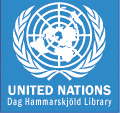|
|
||
|
TAGS
|
||
|
|
||
|
|
||
|
|
||
|
| ||
|
|
||
|
|
||
|
|
||
| |
||||||||||||||||||||||||||||||||||||||||||||||||||||||||||||||||||||||||||||||||||||||||||||||||||||
| |
||||||||||||||||||||||||||||||||||||||||||||||||||||||||||||||||||||||||||||||||||||||||||||||||||||
| |
||||||||||||||||||||||||||||||||||||||||||||||||||||||||||||||||||||||||||||||||||||||||||||||||||||
|
IntroductionSeries symbol records are created to provide access to UN documentation by authority-controlled series symbols. The series symbol is the root of the UN document symbol and represents the UN body to which a series of documents belongs; it may also represent a specific session or meeting of a UN body for which documents are issued, or a series of publications. In UNBIS, the series symbol is the main entry heading, since it represents the corporate body primarily responsible for the document. Two different types of series symbol authority records are created: non-sessional series symbol records, and series symbol records established for specific sessions or meetings. A non-sessional series symbol record must be created when a sessional series symbol record is created for a session or meeting in a new document series. The non-sessional series symbol record includes certain tags that are not assigned to sessional series symbol records (490, 680, 690, 925, 930, 950 and 970) while sessional series symbol records have subfields that are not assigned to non-sessional records: subfield 190 $c containing the session number or year; subfield 975 $b containing the session number, place and dates in English; and subfield 976 $b containing the session number, place and dates in French. Symbols of United Nations documents are composed of capital letters combined with numerals, usually Arabic. When Roman numerals are used they usually indicate the ordinal number of the session or of the subsidiary organ. The oblique stroke (/) is used to separate the components of the symbol.No spaces should be recorded within a document symbol except: (a) spaces between elements in compound phrases in document series symbols (e.g. TD/B/C.1/IRON ORE/, TD/CODE TOT/); (b) cases where spaces occur between words (e.g. income sect.1, Part One). A space between a word and a number should be omitted: A/62/17(PartI), S/PV.6201(Resumption1).
Click on the following links to go to specific information:
Basic series of subsidiary organs are usually numbered in the order of their establishment or convocation.
The documents of some subsidiary organs bear a symbol consisting of the basic series symbol
of the parent body followed by the acronym of the subsidiary organ, e.g.:
i) Elements denoting the nature of the document:
ii) Elements denoting modification of the text:
iii) Elements denoting distribution category:
Maintained
by the Department of Public Information (DPI), Dag Hammarskjöld
Library. Comments as well as suggestions for further
additions/enhancements may be directed to the Dag Hammarskjöld Library.
Last updated: 16 October 2009 |
